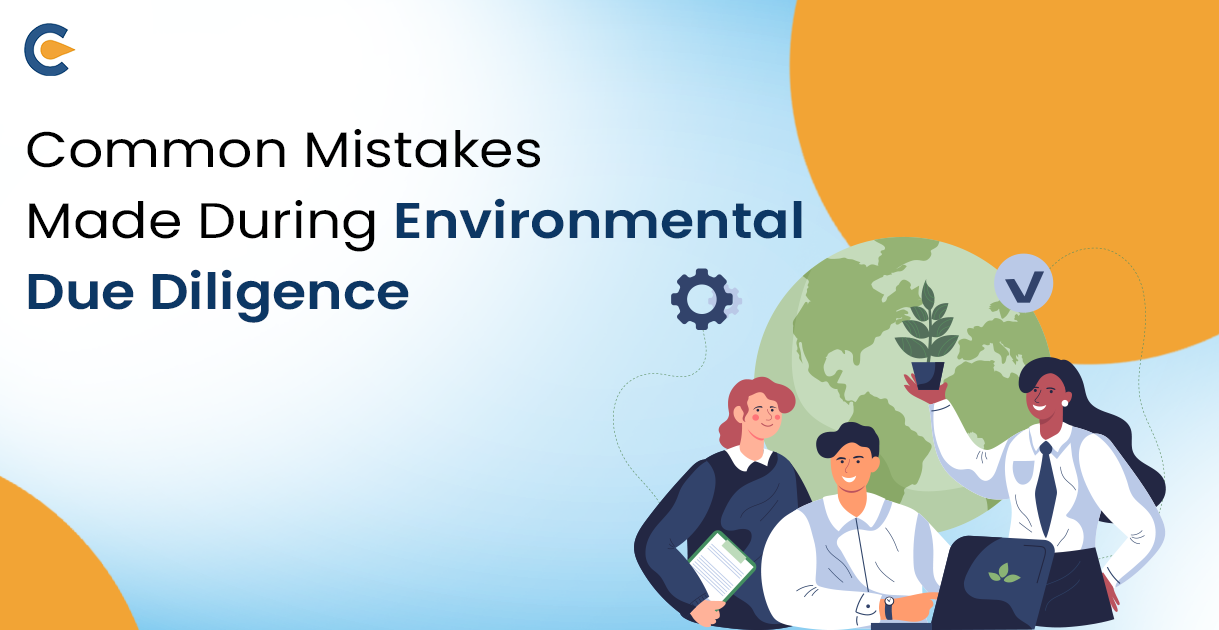When making assessments regarding new property acquisitions, environmental due diligence (EDD), sometimes known as the “ecological audit” of industrial firms, administrative buildings, or undeveloped land plots intended for subsequent projects, is a crucial component. An extensive assessment of a specific property’s potential environmental dangers is the goal of environmental due diligence (EDD). The audit offers the customer a determination of the property’s compliance with relevant environmental legislation, together with an estimate of the potential risks and expenses related to corrective actions.
Common Mistakes Made During Environmental Due Diligence
Some of the common mistakes made during environmental due diligence are:
Inadequate Interaction with Environmental Experts:
One of the common mistakes made during environmental due diligence is failing to consult with competent environmental specialists at every stage of the due diligence procedure. Environmental data can be overlooked and interpreted incorrectly if internal knowledge is the only source of information used or if the value of specialist knowledge is undervalued. Working with knowledgeable environmental consultants reduces the possibility of overlooking important details that might have an influence on the environmental health of the site and guarantees a complete and accurate evaluation.
Inadequate Documentation:
The next common mistake made during environmental due diligence is inadequate paperwork. It may be difficult to defend against future claims or disputes if the environmental due diligence process and results are not adequately documented. Thorough documentation guarantees openness, promotes stakeholder contact, and creates a transparent record of the evaluation procedure.
Lack of Communication:
The other common mistake made during environmental due diligence is less or lack of communication. Misunderstandings and delays may result from poor communication between buyers, sellers, environmental experts, and legal counsel, among other players. Good communication makes sure that everyone is aware of any environmental problems and can cooperate to solve them quickly.
Ignoring Possible Contamination Sources:
Unexpected liabilities and cleanup expenses may arise from a failure to locate and assess possible sources of contamination on or close to the property. This includes close-by waste disposal facilities, industrial sites, and activities that could have an influence on the quality of the environment. This is one of the most common mistakes made during environmental due diligence.
Insufficient Site History Review:
Inadequately researching a site’s past is a common error in environmental due diligence. Neglecting environmental hazards may result from depending exclusively on past reports without conducting a comprehensive historical investigation of the property. If historical data is not collected thoroughly, important details like previous contaminations, changes in land use, or industrial operations that may have an influence on the site’s current condition might be overlooked. Insufficient information is always a common mistake made during environmental due diligence.
Insufficient Scope:
The next common mistake made during environmental due diligence is insufficient scope. Not carrying out a complete evaluation entails not fully analyzing all the environmental hazards and liabilities related to a real estate or commercial transaction. This might entail ignoring important problems like contaminated soil, contaminated water, or dangerous items.
Ignorance of Regulatory Compliance:
Unexpected expenses may result from failing to evaluate adherence to environmental laws and licenses. If a property or company activity breaches environmental rules, there may be regulatory fines, penalties, and required repair activities. Having no regulatory compliance is a common mistake made during environmental due diligence.
Over-reliance on Historical Data:
If historical data is the only source used, without doing on-site inspections or samples, current or ongoing environmental concerns may be overlooked. Historical data could not represent recent incidences, changes in nearby activity, or changes in land use. Over reliance is also a common mistake made during environmental due diligence.
Underestimating Potential Future Environmental Problems:
One major overlook is not anticipating and evaluating potential future environmental problems. As companies develop and environmental standards change, new dangers may arise. Companies need to keep up with changing regulations and consider how their operations may be impacted by these changes. Ignoring future risks might lead to unanticipated liabilities and problems with regulatory compliance, which is a common mistake made during environmental due diligence.
Practices for Effective Environmental Due Diligence
There are some common practices for effective environmental due diligence. With these practices for effective environmental due diligence, one can ensure that fewer mistakes are made.
- To avoid the common mistake made during environmental due diligence of not having a site assessment, conduct a holistic site assessment. All the current and past data should be considered, and an assessment should take place.
- The next best practice is to have a deep regulatory compliance review. A thorough examination of the site is very vital. The absence of this review is quite a common mistake made during environmental due diligence.
- Continuous adaption and monitoring are also very important. This is also often a very common mistake made during environmental due diligence.
- A collaboration with industry and environmental experts will lessen the common mistakes made during environmental due diligence.
Environmental Due Diligence with Corpbiz
With Corpbiz’s environmental due diligence services, you can make your company endeavours successful in today’s competitive market. The significance of environmental due diligence is recognized by our team of experts and professionals. Our experts keep abreast of any amendments, updates, and changes to rules and regulations to ensure that your company is compliant and that you don’t make any unintentional mistakes.
Frequently Asked Questions
What is Environmental Due Diligence?
Environmental Due Diligence (EDD) is a crucial evaluation procedure that is carried out when purchasing real estate. It involves assessing environmental hazards, making sure regulations are followed, and projecting related expenses.
Why is it so important to engage environmental specialists while doing due diligence?
Insufficient communication with environmental specialists might result in data errors and oversights. Getting expert advice guarantees a thorough and precise environmental assessment.
Why is the environmental due diligence process dependent on documentation?
A clear record of the review process is created by thorough documentation, which also fosters openness, protects against future disagreements, and facilitates stakeholder communication and responsibility.
What effect does communication have on the process of environmental due diligence?
Ineffective communication can lead to miscommunication and delays. During due diligence, efficient communication between parties guarantees prompt resolution of environmental concerns.
Which sources of contamination are frequently disregarded when doing due diligence?
Neglecting to identify and evaluate adjacent sources of pollution, including industrial sites or waste disposal facilities, might result in unanticipated liabilities and cleaning costs.
Why is a thorough analysis of the site's past crucial to due diligence?
If a site's past isn't thoroughly examined, it might be possible to miss previous contaminations, land use changes, or industrial activities that have an influence on the site's current state.
How does environmental due diligence suffer from scope underestimation?
Ignoring problems like polluted water or soil in an incomplete assessment might result in unanticipated liabilities. Ensuring that all environmental threats are taken into account requires a thorough examination.
When conducting due diligence, what hazards result from not understanding regulatory compliance?
Neglecting to assess compliance with environmental regulations might lead to unforeseen fines, penalties, and necessary repairs, which would affect the financial part of a deal.
Why could an excessive dependence on past data pose a risk to due diligence?
Strictly depending on past data without conducting on-site inspections might result in the neglect of recent occurrences, shifting activity in the area, or ongoing environmental issues.
Why should businesses prepare for possible environmental issues in the future?
Ignoring and underestimating future environmental hazards might result in unanticipated obligations. An essential component of efficient environmental due diligence is the ability to adjust to evolving laws and industry norms.
Read Our Article: Environmental Due Diligence











